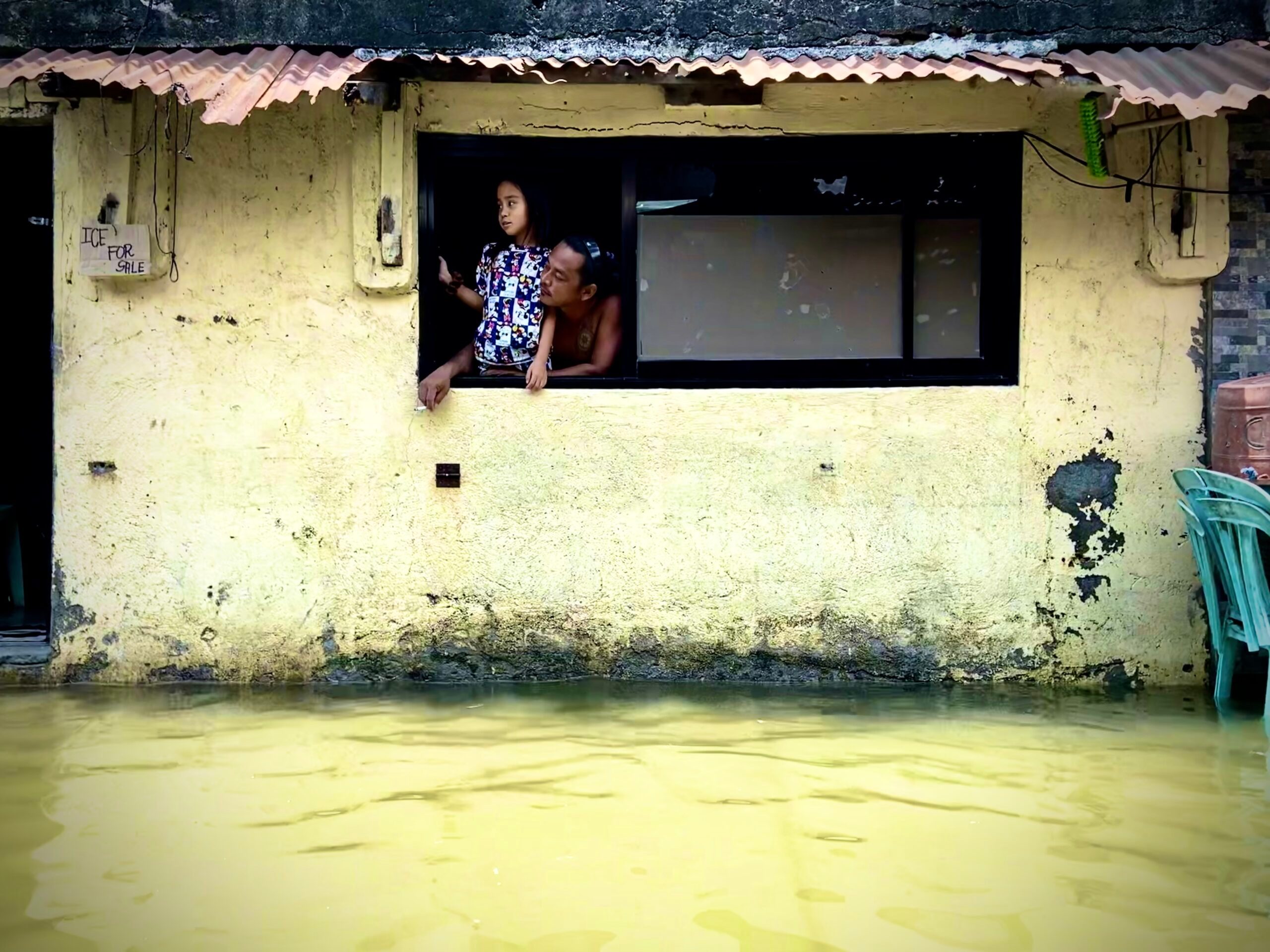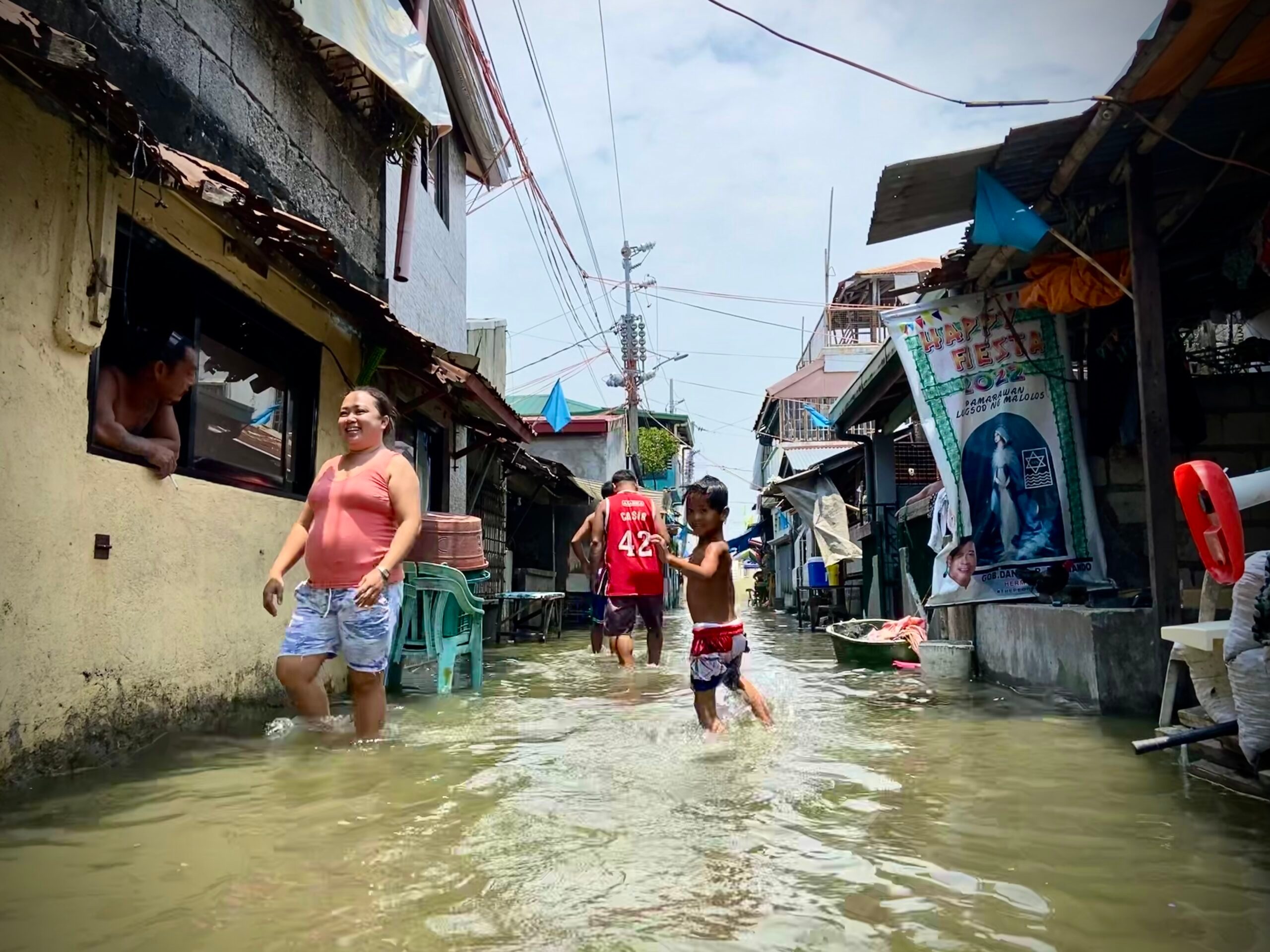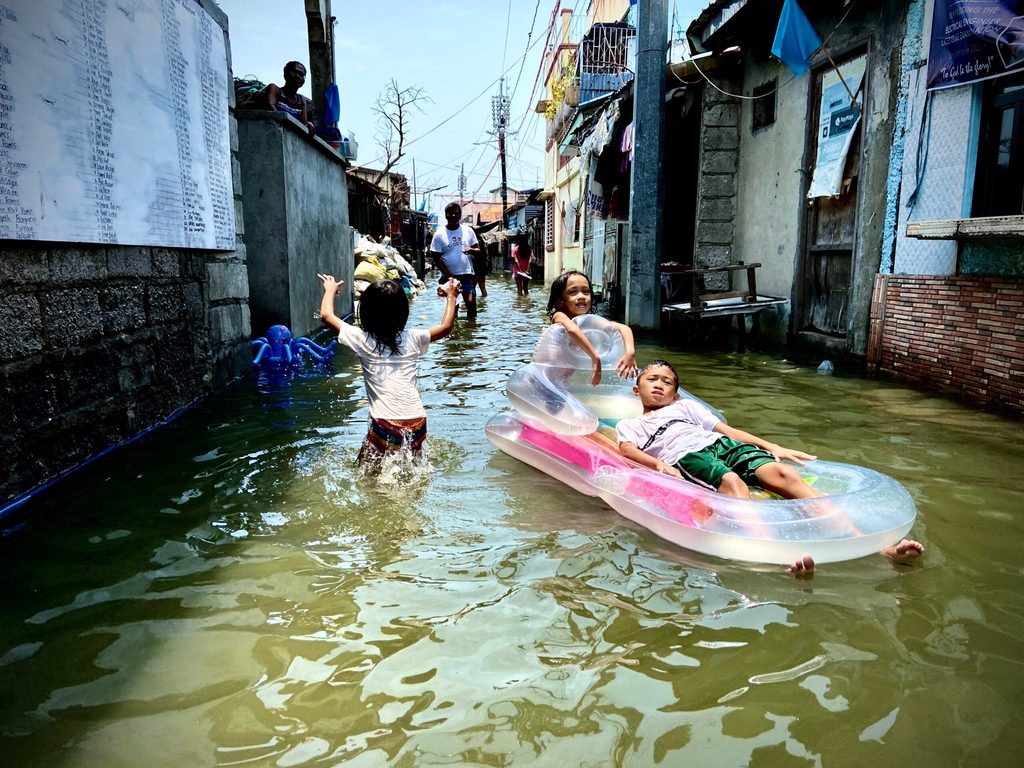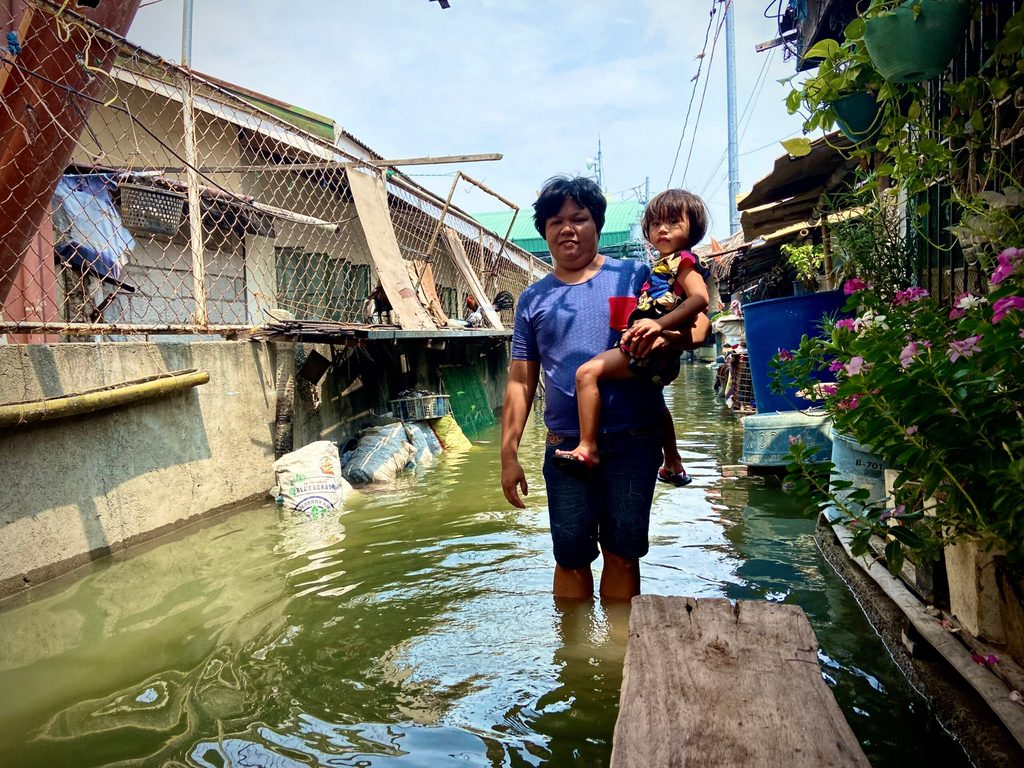SUMMARY
This is AI generated summarization, which may have errors. For context, always refer to the full article.

MANILA, Philippines – The 7 am sun shone bright and the sky was clear, but 35-year-old Sarah Bonghanoy started her day with an unwelcome but all-too-familiar visitor.
As the water seeped through the door crevice, Sarah turned her attention to the family calendar on the wall. It forecasted a 4.9-meter high tide for the day, the highest in the month of June.
“Naku, mabuti na lang at walang bagyo ngayon, kung sinabayan pa ito ng bagyo lulubog talaga kami at mahihirapan,” she said. (It’s good that there is no typhoon today. If there was one, we would surely be submerged.)
But in such an event when the tide or a storm surge inundates their home, Sarah carefully places what little they have – washing machine, clothes, electric fan – on elevated surfaces.
When the floods invade her home at night, Sarah curls up in her bed and could not help but worry not about their belongings, but for the safety of her four small children.
“There are times when we are caught by high tides at night. My husband and I would wake up to clean up and forgo sleep because we need to keep an eye on our children. It doesn’t matter if things get wet as long as the children are safe,” she said in Filipino.
Sarah and the more than 5,000 residents of Isla Pamarawan have learned that dealing with flood waters is a small price to pay for living on the Island, where the ebb and flow of water gives them food and jobs, and defines their collective existence.
In recent years, however, the sea has been rising faster and at levels they have not seen before. Their beloved island home is gradually sinking, along with their hope for a better future.
Knee-high and higher
Nestled in Malolos, Bulacan, Barangay Pamarawan is a 264-hectare island barangay situated approximately 26 kilometers north of Manila.
Part of the vibrant fishing communities along Manila Bay, it is among the coastal areas in the Philippines that face the threat of gradual submersion amid sea level rise due to climate change.
Dr. Laura David, director of the UP Marine Science Institute and an oceanographer who has studied sea level rise in the Philippines, said the country is grappling with a sea level rise that surpasses the global average threefold.
“Through our observation spanning three decades, we have noted a consistent upward trend in the surrounding waters of the Philippines, with a rate of sea level rise ranging from 7 to 10 centimeters per decade,” David said.
David emphasized that sea level rise poses a significant threat to the entire Philippines, especially in coastal regions facing the Pacific and the west-northwest side, including Manila Bay.

Isla Pamarawan is one of the coastal communities in the country that is greatly affected by the fast sea level rise. Photo by Jezreel Ines
In their study, David and colleagues identified all coastal areas in Bulacan to be at a “very high risk” of sea level rise and moderate flooding.
“As a result, Bulacan is recognized as a highly sensitive region when it comes to the challenges posed by sea level rise,” she added.
In 2050, Pamarawan and neighboring barangays and cities along Manila Bay are projected to be submerged by floodwater, with flooding extending towards Valenzuela City, according to data from Climate Central, a non-profit group of scientists and communicators specializing in climate change visualizations.
Sea level rise is a slow-onset disaster, but higher tides in combination with a powerful storm can wreak havoc on communities, like when Sarah almost lost her then three-year-old son to Typhoon Pedring in 2011.
“May bagyo noon pati high tide, abala kami mag-evacuate nang gabing iyon, nagtatakbuhan kami. Hindi ko namalayan iyong anak ko nawawala na, akala ko nalunod na iyong anak ko sa baha. Mabuti na lang nailigtas siya ng mga tanod,” she recalled with anguish.
(There was a typhoon at that time, along with the high tide. We were busy evacuating that night, running around. I later realized that my child was missing, I thought he was drowned in the flood. Thankfully, he was rescued by the village watchers.)
In the last 65 years, from 1951 to 2015, the Philippines has experienced more frequent and more intense tropical cyclones, with wind speeds exceeding 170 kilometers per hour.
This trend has caught the attention of experts and is expected to persist in the future, as highlighted in the comprehensive report on Observed Climate Trends and Projected Climate Change in the Philippines.
At the forefront of the devastating impacts of powerful cyclones and swift rise in sea levels are coastal communities and fisherfolk, who remain the poorest sector in the Philippines as of 2021, according to the Philippine Statistics Authority. There are almost 1.9 million fisherfolk in the Philippines as of 2015.
But it is young people in coastal areas who are most vulnerable to sea level rise, according to the United Nations Children’s Fund (Unicef).

Robi Ann Roxas, a 17-year-old Grade 11 student on the island, wades through knee-deep waters every single day, carefully placing each step and braving the challenging conditions that transform her path to school into a waterlogged maze.
“Kapag ganoon, binabaon na lang namin iyong uniform sa school tapos doon na kami nagbibihis,” she said. (When that happens, we just bring our school uniforms and get dressed there.)

This constant exposure to flood waters gives Roxas discomfort, causing sore feet and occasional muscle cramps.
“Masakit talaga siya kasi lagi akong nababasa. Ang sabi po sa amin ay bumili na kami ng sandals na puwedeng pang-school pero hindi naman po namin mauna iyon kaysa pambili namin ng pagkain sa bahay,” she said.
(It is truly painful because I constantly get soaked. We were advised to purchase school sandals, but we cannot prioritize buying them over food at home.)
Not just climate change
On top of rising sea levels and increasingly more powerful storms, the inhabitants of Isla Pamarawan find themselves locked in a battle not only against the forces of nature, but also against the consequences of the construction of an airport.
Benny Bonghanoy, 46, reminisced about the bygone years when fishing was easier in the waters surrounding the island.
A few decades ago, they did not have to devote an entire day to fishing, but they could easily catch crabs, fish, and shrimps locally called paraw – after which the island was named.
He and his fellow fishermen, however, noticed that their catch declined and the waves were stronger when the construction of the neighboring New Manila International Airport (NMIA), situated merely eight kilometers away, commenced in 2021.
“Noong umpisa po kasing hinukay iyan [tinatayuan ng airport] naging matulin na po ang laki ng tubig. Ngayon po kalahating oras lumalaki na agad ang tubig kapag high tide. Ganoon na po siya kabilis,” he said.
(Now that it was being excavated [for the airport construction], the water level rose rapidly. Now, during high tide, the water quickly increases within half an hour. It has become that fast.)
Set to become the largest airport in the Philippines and meant to help decongest the Ninoy Aquino International Airport (NAIA), the NMIA is currently being constructed along the coastal areas of Bulakan, Bulacan, and is situated approximately 35 kilometers north of the Philippine capital. (READ: Airport City displaces Bulacan fisherfolk)
As a key initiative under President Rodrigo Duterte's "Build! Build! Build!" program, the NMIA, developed by San Miguel Corporation (SMC), is hailed as a “game changer” and is expected to create a million jobs and boost Bulacan's local economy.
However, for fisherfolk like Benny, the construction of the new airport does not hold the same promise of bringing development and progress to their lives.
“Ngayon, sa lebel nga po ng tubig na lumalaki, matulin po ang uwi namin, hindi rin kami nakakapanatili sa dagat nang ganoon katagal kasi baka abutan kami ng ihip ng hangin,” he said. (Now, with the rapidly rising water level, we quickly head home, unable to linger by the sea for too long for fear of being caught by a gust of wind.)
Fernando Hicap, national chairperson of the fisherfolk alliance Pamalakaya Pilipinas, expressed concern about the reclamation projects taking place along the Manila Bay coast, particularly the development of the new airport.
"The situation is truly a disaster. The reclamation activities in Bulakan, Bulacan are causing irreparable damage to the mangrove areas. By destroying the natural habitats and breeding grounds of fish, the very sources of livelihood for the local communities are being compromised,” Hicap told Rappler.
Charlie Javier, barangay kagawad of Brgy. Pamarawan, revealed that the affected individuals of the new airport construction were provided with a financial compensation amounting to a mere P30,000 by the developers.
“They [SMC] assured us that they would provide employment opportunities to our fellow island residents once the airport is completed, as a way to support our community,” Javier said.
But for Benny and other fishermen on the island, fishing and the ocean have been their way of life and have become a vital part of their identity.
“Hindi na po kami kumikibo kasi siyempre sila naman po ang nakakaalam, sila naman po ang nakakataas. Kung magreklamo kami, wala naman po kaming magagawa,” he said.
(We no longer speak up because, of course, they are the ones who know better, they are the ones in power. If we complain, we cannot do anything about it.)
Changing the tides
David stressed the importance of the government taking proactive measures in revising development plans and consistently taking into account the dangers posed by sea level rise.
"As we advance in our pursuit of new development plans, encompassing the placement of an airport, roads, hospitals, and schools, it is crucial to prioritize their locations at significantly higher elevations, preferably five to seven meters above the sea level, particularly in coastal areas," she said.
Hicap further mentioned that the ongoing reclamation projects will not only have an impact on marine life, but also jeopardize the food security of the nation.
“If these circumstances persist, not only will the livelihoods of our fishermen be jeopardized, but our overall food security will also be significantly impacted. Thus, the consequences are far-reaching and have a profound effect on us,” he explained.
Beyond the allure of urban development and progress, Benny’s simple aspiration is for them to continue fishing and for their island to flourish and stand resilient.
“Kasi kung pag-develop naman ng lugar, kung nakakapinsala naman sa hanapbuhay ng tao, iyon po ang hindi namin inaasahan,” Benny said. (Because when it comes to development, if it harms people's livelihoods, that's not what we anticipated.)
Sarah, however, holds on to the hope that when the time comes the airport is completed, the government will provide assistance and support to allow them to sustain their way of life on the island.

“Kawawa ho ang mga tagaritong mahihirap, paano ho kami ‘pag dating ng araw na ‘pag gawa na ang paliparan, itatapon na lang po ba kami sa dalatan sa Malolos?” Sarah asked.
(It’s a pitiful situation for us poor residents. What will happen to us when the airport is constructed? Will we just be thrown away and relocated to the city?)
But for Pamarawan’s youth like Roxas, there is a humble yet profound dream for their cherished island home.
“Sana sa pagtanda ko may maabutan pa rin akong Isla Pamarawan,” she said. (I hope that when I grow old, Isla Pamarawan will still exist.) – Rappler.com
Add a comment
How does this make you feel?





There are no comments yet. Add your comment to start the conversation.